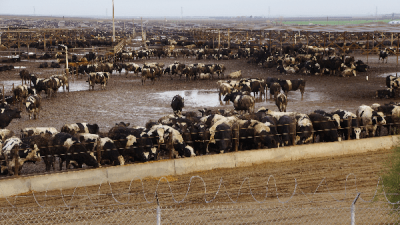Last week, thirteen public interest organizations sued the Environmental Protection Agency (EPA) over the agency’s alleged failure to regulate factory farm pollution under the Clean Water Act.

The lawsuit contends that the EPA’s regulation of animal waste emissions from “concentrated animal feeding operations” (CAFOs) is “ineffective.” Instead of issuing guidelines for such operations, EPA elected to form a study group to evaluate the situation and make recommendations, “delaying action until at least 2025—that is, if the agency decides to act at all,” according to a press release from the Center for Food Safety, one of the plaintiffs.
“Fewer than one third of the country’s 21,000+ largest factory farms have National Pollutant Discharge Elimination System (NPDES) permits,” contends the Center for Food Safety.
Nevertheless, the plaintiffs cite a 2003 EPA estimate “that CAFOs generated more than three times the amount of raw sewage than that of our human population; since then, the industry has grown by about 40 percent.”
“The Trom family farm in rural Dodge County, Minnesota is surrounded by 12 swine factory farms in a 3-mile radius,” said Sonja Trom Eayrs, attorney, rural advocate, farmer’s daughter, and cofounder of Dodge County Concerned Citizens in Minnesota, another plaintiff. “Like many families in rural America, ours must contend with dangerous discharges from neighboring factory farms on a daily basis. We’ve contacted the regulators on several occasions, with little to no assistance. What do you do if the regulators will not regulate?”
The plaintiffs are Food & Water Watch, Center for Biological Diversity, Center for Food Safety, Dakota Rural Action, Dodge County Concerned Citizens, Environmental Integrity Project, Helping Others Maintain Environmental Standards, Institute for Agriculture and Trade Policy, Iowa Citizens for Community Improvement, Kewaunee CARES, Land Stewardship Project, Midwest Environmental Advocates, and North Carolina Environmental Justice Network.
In California, the food safety program for the Leafy Greens Marketing Agreement (LGMA) BB #:210653, which regulates biological pollution of leafy greens, “already includes restrictions that don’t allow leafy greens to be planted in areas of high risk. The program has minimum buffer zones in place for areas in the proximity of animals. For example, under the California LGMA, leafy greens cannot be planted within a mile of a large Concentrated Animal Feed Operation or CAFO,” writes LGMA president Tim York.
Nevertheless, “the court action heats the issue of cattle yards polluting nearby leafy green fields without a meaningful solution,” writes Dan Flynn, editor of Food Safety News.



